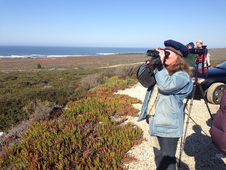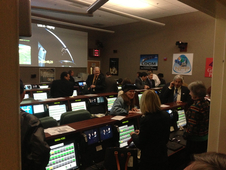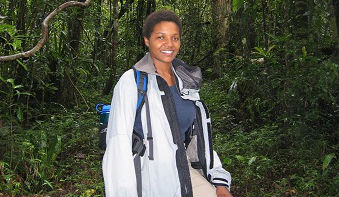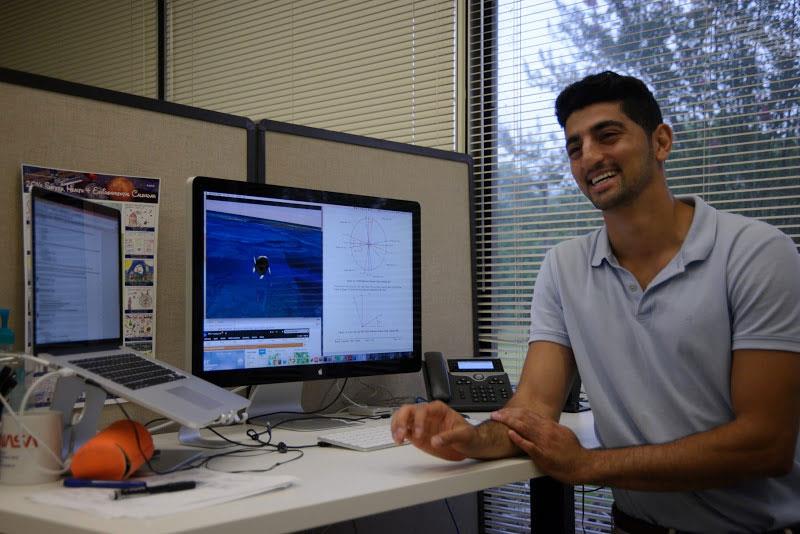STEM Career Connections
Meet Elizabeth Forsbacka, Landsat Instrument Manager

Job Title
Instrument Manager
Elizabeth Forsbacka
Bio
What do you do and what is most interesting about your role here at Goddard? How do you help support Goddard’s mission?
As an instrument manager, I lead a diverse team to design, build and test Earth or space science instruments. My job is to build a good team that can do it all. Our work from design through delivery of the spacecraft usually takes about four years.
What was the last instrument you worked on?
My last instrument was the Thermal Infrared Sensor Instrument for the Landsat Data Continuity Mission (renamed Landsat 8 after launch) that is currently orbiting the Earth. I started as the deputy instrument manager and then became the overall instrument manager.
The TIRS instrument measures temperatures on the surface of Earth. This instrument remotely senses warm and cool areas on Earth to indicate how well an area is irrigated. This information is important for water resource managers in managing water as a scarce resource.
We imaged a volcano including the ash plume. We recently imaged the coldest spot on Earth in the mountains of Antarctica. We’ve made national news for both of these amazing images and their impact on science.
I was on the TIRS team from the beginning. I was the instrument manager for the phase where we integrated the instrument onto the satellite. This is a very precise activity. We even did a dry run with an instrument simulator to make sure that all of our procedures would work and that everything would fit. Next we prepared the entire observatory (with TIRS as one of the two instruments) for flight and successfully launched on Feb. 11, 2013.
What will Landsat 8 send back to us?

Image Credit: Courtesy of E. Forsbacka
After a successful launch and check out of operational capabilities, NASA turned over operation of this satellite to the U.S. Geological Survey. Landsat 8 is an Earth satellite that orbits Earth every 90 minutes while it takes continuous images of Earth’s surface. Each spot on Earth is imaged every 16 days. The Landsat satellites have been doing this for over 40 years. Landsat 8 is the eighth satellite in the series and continues to add to the archiving of these global images.
Are there other uses for this imagery?
Anyone who has ever used Google Earth has used this data. Google Earth stitches together the images from Landsat and other sources to make their maps. Any time you see an image of Earth from space and then it zooms down into a view of a particular city or even spot on Earth, you are using Landsat imagery.
Please tell us about your current year-long detail to the National Oceanic and Atmospheric Administration?
I’ve gone from working on land data from satellites to working on ocean and atmospheric data from satellites. I’m like a scientific sailor, moving from land to the sea. My work images the atmospheric conditions that may create hurricanes, tornados and other extreme weather events. Plus, I can now walk to work!
What are you doing for NOAA?

I work for the systems engineering arm of the National Environmental Satellite, Data and Information Service. I recommend the space architecture of NOAA’s weather satellites (which NASA builds) decades into the future. Right now, we’re looking at what we will need about 25 years from now. It’s critical for weather forecasters to have information from satellites in order to make accurate weather predictions. This satellite capability affects every person on Earth.
How are your images of atmospheric conditions incorporated into weather reports?
The National Weather Service is part of NOAA. When the NWS issues a severe weather alert, I sometimes get the background the next day at work on how the call was made. Sometimes after a snow event, I talk with the people who made the call and learn about the difficulties they had in making their weather prediction. The Washington area is always on the edge between rain and snow, so calls are often very difficult to make. We live in a world of probabilities. We will never be able to predict the weather perfectly.
Why did you become an engineer?
My father is an electrical engineer. He was a big part of my decision to become an engineer and made sure that I considered engineering as an option. When I was 18, I would not have considered this on my own. My bachelor’s degree is in electrical engineering. I have a master’s degree in electrical engineering and a second master’s degree in materials science.
Do you do any outreach?
Yes, a few weeks ago, I participated in a panel Google Hangout that was streamed online to middle school girls. I spoke about being an engineer for NASA and what my day is like, much as we’ve done in this interview. I tried to focus on my successes, but also on my trials, as both build character. I wanted the girls to understand that life is a mix of good and bad. After everyone spoke, the girls asked questions.
What advice did you give to these girls?
I told them to build their network using their community beyond just their family. I also said that I got my first engineering job through a friend of my father who also went to our church. I came to NASA much the same way, through a friend of my husband. I told these girls that they have to learn to be their own best advocates and not to be afraid to ask their network for help in achieving their goals.
What is the coolest thing you’ve ever done as part of your job at Goddard?
My husband and I were at the launch of Landsat 8. It was surreal and quite emotional. I was the point person who answered a lot of the media’s questions, so I was very close to the pad.
You see the rocket lift off the pad first. Then, because light travels faster than sound, you start to feel the deep rumble in your chest from the pressure waves. It was very powerful, emotional and even physical.
Where is your favorite place to go to relax with your family?
Every weekend, my husband, three daughters and I go to our cabin in Calvert County just north of the Calvert Cliffs nuclear power plant. We are a few hundred feet from the water and can see the sunrise over the bay. We have the best of both, woods and water.
We completely disconnect from the world. We don’t have a telephone, internet or television. We bring a cell phone in case of emergency, but we have to walk out to a hot spot for service.
It’s so peaceful and restful. It’s our passion. We read, bake, take long walks on the beach and look for fossilized shark’s teeth, which are millions of years old.
We live the “Little House on the Prairie” life. I love this quote from Laura Ingalls Wilder: “It is the sweet, simple things of life which are the real ones after all.” To me, it is the simple pleasures that make up a good life—both from work and from home.




